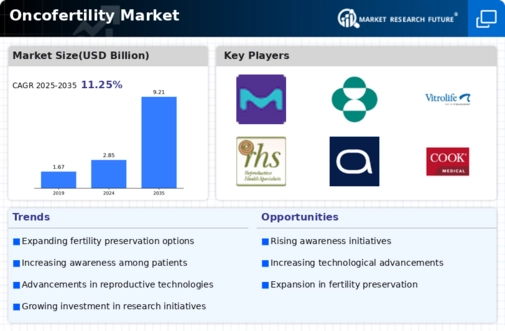Rising Incidence of Cancer
The Oncofertility Market is influenced by the rising incidence of cancer, which has been steadily increasing over the years. Statistics indicate that nearly 1 in 2 men and 1 in 3 women will be diagnosed with cancer in their lifetime. This alarming trend has heightened the demand for fertility preservation options among cancer patients, as many face the risk of infertility due to aggressive treatments. As awareness grows regarding the impact of cancer therapies on reproductive health, the Oncofertility Market is likely to expand, with more patients seeking services to safeguard their future reproductive capabilities.
Increased Patient Advocacy and Support
The Oncofertility Market is benefiting from increased patient advocacy and support organizations that focus on fertility preservation. These organizations play a crucial role in educating patients about their reproductive options before undergoing cancer treatment. Initiatives aimed at raising awareness have led to a notable increase in consultations for fertility preservation, with some clinics reporting a 30% rise in inquiries. This advocacy not only empowers patients but also drives the demand for oncofertility services, thereby contributing to the overall growth of the market.
Technological Innovations in Oncofertility
The Oncofertility Market is experiencing a surge in technological innovations that enhance fertility preservation techniques. Advanced cryopreservation methods, such as vitrification, have significantly improved the success rates of oocyte and embryo freezing. According to recent data, the success rate of frozen embryo transfers has reached approximately 50%, indicating a promising future for patients seeking fertility preservation. Additionally, the development of artificial intelligence in reproductive medicine is streamlining patient management and improving outcomes. These technological advancements not only provide better options for cancer patients but also expand the market potential for fertility preservation services.
Regulatory Support and Funding for Research
The Oncofertility Market is positively impacted by regulatory support and funding for research in reproductive health. Government initiatives aimed at promoting fertility preservation research have led to increased investment in innovative technologies and treatment options. For instance, funding from health agencies has facilitated clinical trials that explore new methods of preserving fertility in cancer patients. This financial backing not only accelerates advancements in the field but also enhances the credibility of oncofertility services, potentially attracting more patients and expanding the market.
Integration of Oncofertility into Cancer Care
The Oncofertility Market is witnessing a trend towards the integration of oncofertility services into standard cancer care protocols. Multidisciplinary teams, including oncologists, reproductive endocrinologists, and mental health professionals, are increasingly collaborating to provide comprehensive care for cancer patients. This integration ensures that fertility preservation discussions occur early in the treatment process, which is crucial for maximizing options. As more healthcare institutions adopt this holistic approach, the Oncofertility Market is expected to grow, reflecting a shift towards patient-centered care that prioritizes reproductive health.


















Leave a Comment